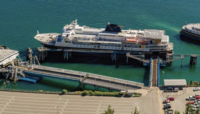With $4.3 billion allocated this year alone to Amtrak under the federal infrastructure law —and at least $22 billion over its lifespan—the nationwide intercity passenger rail provider is preparing for an unprecedented amount of construction by staffing up and embracing an array of project delivery methods.
On Dec. 5, Amtrak announced its plan to seek a delivery partner for the B&P Tunnel Replacement Program in Baltimore, after more than two dozen industry firms responded to its Request for Information (RFI) on the model in which the private partner takes on substantial risk-sharing, impacting overall project outcomes.
The railroad this summer issued a solicitation for letters of interest in a construction manager-at-risk contract (CMAR) for the $1-billion first major contract of three planned that make up the nearly $5-billion megaproject. That contract for the southern approach is in the Request for Proposal stage and includes a new ADA-compliant MARC station, excavation and some utility and roadway work.
Amtrak created in January a new capital delivery group that has ramped up from 200 to 600 in preparation for what could be $40 billion in projects ranging from track work to stations to signal systems to new railcars. “We are setting up a top-notch construction business,” says Tony Ryan, Amtrak vice president of program development and project services. “We need to perform all capital maintenance and renewal work quickly, plus large-scale projects.”
After the infrastructure law windfall for Amtrak, which has historically been underfunded and not prioritized by Congress, its Office of Inspector General released a report in April cautioning that the railroad needs to demonstrate fiscal responsibility, require robust internal controls, acquire a skilled workforce despite a tight labor market, achieve effective coordination with its stakeholders, coordinate internally across the company and improve program and project management.
“We are making a concerted effort among the capital delivery department and other departments to build work under the [funding law]," says Jaidev Sankar, Amtrak vice president of infrastructure and project delivery. “We recognize that with the volume of work we’re putting out, we and our partner agencies have to partner effectively with private industry.”
Ryan says Amtrak staffers visited the UK to gain lessons learned from megaprojects there, such as HS2 and Crossrail. “There is a mantra of ‘go slow to go fast,’" he says. "So many are joining our organization or have been a part of it for decades, and are excited to go forward. The B&P tunnel has been on the radar for 20 years. Some of the feedback we heard is how to make sure we get the delivery execution right.”
One lesson learned is “to see across the interface of packages, and influence outcomes …. We’re not successful if we wait a couple of years and then go back and get the perspective of security systems, for example,” he says.
Tunneling Ahead
In partnership with the Maryland Dept. of Transportation's Maryland Transit Administration, the B&P Tunnel Replacement Program will replace the existing tunnel with the new Frederick Douglass Tunnel, named for the Maryland native and renowned civil rights leader. As part of the larger strategy to increase capacity and reliability on the Northeast Corridor, the existing B&P Tunnel will be dedicated to freight service, and the new tunnel will be focused solely on passengers.
Built in 1873, the 1.4-mile two-track B&P tunnel is comprised of three short horseshoe-arch brick and masonry tunnels located below several Baltimore neighborhoods. The tunnel is one of the oldest structures on the Northeast Corridor and heavily used by Amtrak and regional commuter trains, as well as freight traffic.
According to the replacement program’s 2017 record of decision, the tunnel is functionally obsolete, with a narrow alignment and grades that limit passenger train speeds to 30 mph. The structure also lacks fire/life safety systems, and suffers from age-related issues such as excessive water infiltration, a deteriorating structure and a sinking floor. Because a single tunnel houses both tracks, no detours are available to northbound or southbound trains in the event of tunnel closures.
Amtrak’s replacement strategy calls for initially boring two new 3.67-mile-long high-capacity tunnel tubes for electrified passenger trains on a new alignment, with provisions for two additional tubes in the future.
The record of decision’s estimated cost for the four-tube alternative was $4.52 billion, assuming construction completion in 2025. Amtrak has not announced an estimated cost for the project, now scheduled for completion in 2032, but it has stated that the two-track option will reduce costs by $1 billion.
Once complete, the new tunnel system will improve travel times for approximately nine million passengers each year who rely on the Northeast Corridor for service, including Amtrak and the MARC Penn Line.
Future construction packages will be announced in 2023. This will include one tunnel package for the twin-bore tunnel construction work, featuring two parallel tunnels, each containing a single rail track.
The Delivery Partner approach will create a “pain share/gain share” approach to payments tied to key metrics and outcomes, says Ryan. The partner will receive reimbursement for overhead costs and a fixed fee over the life of the project.
“This is not something pulled out of a hat,” says Ryan. "It’s been in our thought process for some time.” The feedback from industry has been that “there is an appetite to engage in this type of structure where you’re putting your profit at risk—but on the flip side, you will gain your share. Are private firms willing to put that skin in the game? Across the board, the answer was yes."
Diverse Portfolio
Amtrak in August received the largest single grant in the latest round of the Federal Railroad Administration's State of Good Repair program—$65.2 million to replace a 115-year-old bridge across the Connecticut River. The railroad and the Connecticut DOT will provide a funding match of 38%. That same month, it also received a $40-million grant for final design for the project to replace the moveable Susquehanna River Rail Bridge. Sankar says construction management at risk will be used for construction of a new main span, with design-bid-build for enabling works.
The railroad is also testing new train sets so Acela trains on the Northeast Corridor can increase maximum speeds from 150 mph to 160 mph, and an RFI for long-distance train sets will be released by the end of the year, says Norman Forde, vice president of project delivery, fleet and facilities.
One major part of Amtrak’s capital program is the $16-billion Gateway program, which includes about ten projects to increase capacity between Penn Stations in New York City and Newark, N.J., and replace aging Hudson River rail tunnels.
The new capital delivery arm “is a brand-new exercise for us,” says Marie Corrado, Gateway program senior director. “My function at Gateway is to conceive, design and construct. Before, this was our job alone. Now that the money is here, and support from the [Biden] administration is here, we have to grab this moment."





Post a comment to this article
Report Abusive Comment